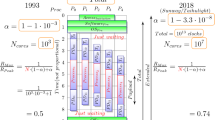Abstract
This article introduces a mathematical function that describes the latent concurrency inherent in an arbitrary program with given initial conditions. The concurrency function is used to derive asymptotic estimates for speedup, including Amdahl's Law. It provides a new method for analyzing cost-effectiveness of the processor-memory-communications constituents of a computing system for applications where system cost and execution time are mutually elastic variables. The costs of programming and input/output are not taken into account in the present study. The methods are applied to study the relative advantages of serial versus concurrent processing; the relationship of the memory/processor ratio to cost-effectiveness; the conditions that determine the relative advantages of SIMD and MIMD control structures; the effects of various interprocessor communication strategies; and cost-effectiveness implications of the choice of data path width.
Similar content being viewed by others
References
Amdahl, G. M. 1967. Validity of the single processor approach to achieving large scale computing abilities. Proc. AFIPS, 30, 483–485.
Batcher, K. E. 1980. Design of a massively parallel processor. IEEE Trans. on Computers, C-29, 9(Sept.), 836–840.
Batcher, K. E. 1976. The flip network in STARAN. 7976 Proc. Int. Conf. Parallel Processing, pp. 65–71.
Brent, P. S., and Kung, H. T. 1980. The chip complexity of binary arithmetic. Proc. 12th Annual ACM Symp. Theory Computing, April, pp. 190–200.
Dongarra, J. J., and Duff, I. S. 1985. Advanced architecture computers. Argonne National Laboratory Technical Memorandum No. 57, 4 Sept. (Draft).
Graham, W. R. 1970. The parallel and the pipeline computer. Datamation (Apr.), 68–71.
Greenberg, R. I., and Leiserson, C. E. 1985. Randomized routing on fat-trees (Preprint, 1 May).
Kung, H. T., and Leiserson, C. E. 1980. Systolic arrays (for VLSI). In Introduction to VLSI Systems (C. A. Mead and L. fonway, eds.), Addison-Wesiey, Reading, Mass.
Lau, R. L., Siewiorek, D. P., and Mizel, D. W. 1982. A survey of highly parallel computing. IEEE Computer (June), 9–24.
Leiserson, C. E. 1985. Fat-trees: universal networks for hardware-efficient supercomputing. 1985 Int. Conf. on Parallel Processing, to appear.
Mead, C. A., and Conway, L. 1980. Introduction to VLSI Systems, Addison-Wesiey, Reading, Mass.
Minsky, M., and Papert S. 1971. On some associative, parallel, and analog computations. In Associative Information Techniques (E. J. Jacks, ed.), Elsevier, New York.
Patton, P. 1985. Multiprocessors: architecture and applications. IEEE Computer (June), 29–40.
Schwartz, J. T. 1980. Ultracomputers. ACM Trans. on Programming Languages and Large Systems, 2, 484–521.
Thompson, C. D. 1979. Area time complexity for VLSI. Proc. 11th Annual ACM Symp. Theory Computing (Apr–May), 81–88.
Ullman, J. D. 1984. Computational aspects of VLSI. Computer Science Press.
Ware, W. H. 1972. The ultimate computer. IEEE Spectrum, 9, 3, 84–91.
Author information
Authors and Affiliations
Rights and permissions
About this article
Cite this article
Resnikoff, H.L. Cost-effectiveness of concurrent supercomputers. J Supercomput 1, 231–262 (1987). https://doi.org/10.1007/BF00128048
Issue Date:
DOI: https://doi.org/10.1007/BF00128048




